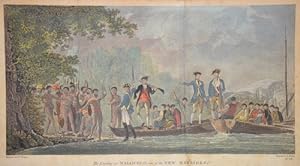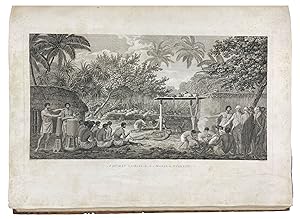Hodges William 1744 1797 (14 results)
FeedbackSearch filters
Product Type
- All Product Types
- Books (8)
- Magazines & Periodicals (No further results match this refinement)
- Comics (No further results match this refinement)
- Sheet Music (No further results match this refinement)
- Art, Prints & Posters (6)
- Photographs (No further results match this refinement)
- Maps (No further results match this refinement)
- Manuscripts & Paper Collectibles (No further results match this refinement)
Condition
Binding
- All Bindings
- Hardcover (No further results match this refinement)
- Softcover (7)
Collectible Attributes
- First Edition (No further results match this refinement)
- Signed (2)
- Dust Jacket (No further results match this refinement)
- Seller-Supplied Images (10)
- Not Print on Demand (12)
Free Shipping
Seller Rating
-
Travels in India, During the Years 1780, 1781, 1782, & 1783
Published by Legare Street Press, 2021
ISBN 10: 1014232686 ISBN 13: 9781014232687
Seller: Lucky's Textbooks, Dallas, TX, U.S.A.
Condition: New.
-
[COOK] Four nineteenth-century photographs of eighteenth-century engravings of Tahitian subjects.
Seller: Douglas Stewart Fine Books, Armadale, VIC, Australia
"Papeete, Tahiti : Mrs. Sophia Hoare, [between 1880 and 1889]. Four albumen print photographs of copperplate engravings, 130 x 203 mm (1. and 2.) / 167 x 130 mm (3.) / 110 x 210 mm (4.); unmounted; versos all with the wet stamp of 'Mrs. S. Hoare, Photographer, Papeete, Tahiti'; (1.) and (2.) with mild damage at bottom left corners, otherwise the prints are in good condition with an expected amount of very light creasing. The significance of this group of photographs of plates engraved by Robert Bernard taken from early French editions of Cook's voyages lies not in the images themselves, for they are well known: the drawings were made by William Hodges and John Webber, artists on Cook's second and third voyages, respectively, in 1773 and 1777. Their interest is more one of association, since - like the original drawings - they were also produced in Tahiti, scarcely one hundred years after Cook's three visits to the Society Islands. The photographs were taken by Papeete photographer Mrs. Sophia Hoare, who sold examples of these images in loose albumen print format as souvenirs to European tourists throughout the 1880s. The images portray aspects of traditional Tahitian society which were dying out by this time, and they clearly held appeal for European travellers who were fascinated by the exotic, as well as by the story of the celebrated navigator, Cook.
-
View in the Island of Pines.
Published by Artist: Hodges William ( - 1797 ) London ; issued in: London; - William Hodges (1744- 1797 ) was an English painter Hodges accompanied Captain James Cook aboard the Resolution on his second voyage to the South Seas including Tahiti the Tonga Islands New Zealand Easter Island and Antarctica During his stay on board Hodges mainly made landscape sketches but also some portraits of expedition members as well as special personalities of the visited islands His landscape paintings usually also include elements showing the way of life of the people visited His sketches were further worked on after his return to London Hodges obtained employment for some time with the Admiralty which allowed him to produce oil paintings from the sketches and to sup, 1744
Art / Print / Poster
Technic: Copper print, colorit: original colored, condition: Minor stains, size (in cm): 24,5 x 38,5 cm; - View of a bay on Pine Island in New Caledonia. Engraved by W. Byrne, edited by Strahan.; History: The settlement of New Caledonia probably took place around 1500 BC by people of the Lapita culture. The descendants of these tribes today form the indigenous people of the Kanaks. In the period from the 11th century to the 18th century, Polynesians repeatedly reached the islands of New Caledonia, as they were in search of new land. The islands were discovered by the Europeans only in the course of the 18th century. In 1774, during his second voyage to the South Seas, James Cook became the first European to set foot on the islands. He gave them their present name because the appearance of the northeast of the main island reminded him of Scotland, which had been called Caledonia by the Romans. Cook explored the island landscape over nine days without any incidents. He was followed in 1792 by a Frenchman named Joseph Bruny d'Entrecasteaux. The first Europeans to settle on the islands were whalers and timber (sandalwood) traders. They were followed by missionaries in the 19th century.
-
A Toupapow with a Corpse on it Attended by the Chief Mourner in his Habit of Ceremony.
Published by Artist: Hodges William ( - 1797 ) London ; issued in: London; - William Hodges (1744- 1797 ) was an English painter Hodges accompanied Captain James Cook aboard the Resolution on his second voyage to the South Seas including Tahiti the Tonga Islands New Zealand Easter Island and Antarctica During his stay on board Hodges mainly made landscape sketches but also some portraits of expedition members as well as special personalities of the visited islands His landscape paintings usually also include elements showing the way of life of the people visited His sketches were further worked on after his return to London Hodges obtained employment for some time with the Admiralty which allowed him to produce oil paintings from the sketches and to sup, 1744
Art / Print / Poster
Technic: Copper print, colorit: colored, condition: little stains, size (in cm): 23,5 x 37,5 cm; - View shows a body laid out in Tahiti, accompanied by the mourning head in his ceremonial robe. Edited by W. Strahan, engraved by W. Woollett, drawn after Hodges.; History: Tahiti was settled - like the other Society Islands - around 200 BC from Tonga and Samoa. It is not conclusively clear which European can be considered the "discoverer" of Tahiti. The Portuguese Pedro Fernández de Quirós sighted an inhabited island in 1606, which he called Sagittaria and which, according to some chroniclers, could have been Tahiti. However, there is no confirmation of this. Today, the Englishman Samuel Wallis is considered the first European to set foot on Tahiti in 1767. The visits of James Cook have remained in the consciousness of Europeans. In April 1769 he anchored with his ship Endeavour in Matavai Bay, about 10 km north of today's Papeete. Traveling with Cook was botanist Joseph Banks, who conducted extensive botanical studies during his three-month stay. His findings led to the fateful 1787 voyage of the Bounty to Tahiti, which was commissioned by the British Admiralty to William Bligh.
-
Resolution Bay in the Marquesas.
Published by Artist: Hodges William ( - 1797 ) London ; issued in: Paris; - William Hodges (1744- 1797 ) was an English painter Hodges accompanied Captain James Cook aboard the Resolution on his second voyage to the South Seas including Tahiti the Tonga Islands New Zealand Easter Island and Antarctica During his stay on board Hodges mainly made landscape sketches but also some portraits of expedition members as well as special personalities of the visited islands His landscape paintings usually also include elements showing the way of life of the people visited His sketches were further worked on after his return to London Hodges obtained employment for some time with the Admiralty which allowed him to produce oil paintings from the sketches and to supe, 1744
Art / Print / Poster
Technic: Copper print, colorit: original colored, condition: Minor stains, size (in cm): 23 x 37,5 cm; - View showing Resolution Bay in the Marquesas Islands with locals on their boats (pirogue). From Alexander Hogg's A New Authentic and Complete Collection of Voyages Round the World. Engraved by Benjamin Thomas, Pouncy. After William Hodges. Published by Lane & Thos Cadell.; History: The Society Islands in French Polonesia. The archipelago is suspected to have been named by Captain James Cook during his first voyage in 1769, supposedly in honour of the Royal Society, the sponsor of the first British scientific survey of the islands. However, Cook himself stated in his journal that he called the islands Society as they lay contiguous to one another.
-
Trombes de mer aupres de la Nouvelle Zelande.
Published by Artist: Hodges William ( - 1797 ) London ; issued in: London; - William Hodges (1744- 1797 ) was an English painter Hodges accompanied Captain James Cook aboard the Resolution on his second voyage to the South Seas including Tahiti the Tonga Islands New Zealand Easter Island and Antarctica During his stay on board Hodges mainly made landscape sketches but also some portraits of expedition members as well as special personalities of the visited islands His landscape paintings usually also include elements showing the way of life of the people visited His sketches were further worked on after his return to London Hodges obtained employment for some time with the Admiralty which allowed him to produce oil paintings from the sketches and to sup, 1744
Art / Print / Poster
Technic: Copper print, colorit: original colored, condition: Perfect condition, size (in cm): 22 x 36,5 cm; - Engraving showing William Hodges observing the waterspouts at Cape Stephens, Marlborough. From the French edition of Cook's second voyage, which first appeared in: Wales & Bayly, The Original Astronomical Observations made in the course of a Voyage towards the South Pole, and round the world, in His Majesty's Ships the Resolution and Adventure. This report provided the astronomical information for Cook's second voyage. The title of the English version was: Waterspouts in Cook's Straits in New Zealand. Engraved by Benard.; History: New Zealand was discovered by Polynesians around the end of the 13th century, or at the latest in the first half of the 14th century, and was settled in several waves of immigration. The descendants of the first immigrants founded the M_ori culture. The first M_ori to reach the land found no mammals. To feed themselves, they first hunted the moa, a flightless bird remotely similar to the African ostrich. The first European to set eyes on New Zealand was the Dutch navigator Abel Tasman. His mission was to find the "Great Southern Land" because valuable raw materials were suspected there. On his voyage, in 1642, he discovered a "great high land" on the South Island, today's West Coast region. He was not sure and suspected that he had discovered another piece of Staten Landt coast. When he went to Golden Bay in what is now the Tasman region to explore the land up close, he had his first bloody encounter with the "aborigines" in which four Dutch sailors were killed. The "discoverer of New Zealand" never set foot on New Zealand soil. A year later, when an expedition under Hendrik Brouwer determined that the coastal strip found by Tasman did not belong to Staten Landt, the country was named Nova Zeelandia (Latin) or Nieuw Zeeland (Dutch), in reference to Australia, which had been called Nova Hollandia or Nieuw Holland. Like Tasman, the British captain James Cook was to find a suspected southern continent. In 1769, Cook's ship Endeavour, coming from Tahiti, encountered New Zealand at the southwestern point of the bay called Poverty Bay. After first hostile encounters, but then also successful approaches with M_ori, Cook first circumnavigated the North Island and, after a longer stay in the Marlborough Sounds, the South Island and was thus able to prove that New Zealand was islands and not part of a continent. Cook and the scientists accompanying him began to map the country thoroughly, they explored flora and fauna extensively and gathered information about the M_ori. Only a few weeks after Cook, Jean François Marie de Surville also reached the islands. In the following years, mainly whalers, sealers and later missionaries migrated to New Zealand. These maintained pronounced contacts with the M_ori. The two parties engaged in lively trade with each other, and some Europeans also lived together with the M_ori.
-
Landing op het Eiland Erramanga, een van de Nieuwe Hebriden.
Published by Artist: Hodges William ( - 1797 ) London ; issued in: ; - William Hodges (1744- 1797 ) was an English painter Hodges accompanied Captain James Cook aboard the Resolution on his second voyage to the South Seas including Tahiti the Tonga Islands New Zealand Easter Island and Antarctica During his stay on board Hodges mainly made landscape sketches but also some portraits of expedition members as well as special personalities of the visited islands His landscape paintings usually also include elements showing the way of life of the people visited His sketches were further worked on after his return to London Hodges obtained employment for some time with the Admiralty which allowed him to produce oil paintings from the sketches and to supervise, 1744
Art / Print / Poster Signed
Technic: Copper print, colorit: black/white, condition: Perfect condition, size (in cm): 21,5 x 44,5 cm; - View showing Captain Cook's landing on Erramanga Island, one of the New Hebrides. After the original drawing by Wiliam Hodges.; History: New Hebrides was the colonial name for the group of islands in the South Pacific now Vanuatu. Native people had inhabited the islands for three thousand years before the first Europeans arrived in 1606 from a Spanish expedition led by the Portuguese navigator Pedro Fernandes de Queirós. The islands were colonized by both the British and the French in the 18th century shortly after Captain James Cook's visit, and the two countries eventually signed an agreement that turned the islands into an Anglo-French housing estate that would include the New Hebrides in divided into two separate communities: one Anglophone and one Francophone. This gap continued after independence, with schools teaching in either one language or the other and with different political parties.
-
Plate volume for Voyage pittoresque de l'Inde fait dans les années 1780-1783. [Or] Travels in India, during the years 1780, 1781, 1782 & 1783. Original edition.
Published by Paris: circa 1793, 1793
Seller: Wittenborn Art Books, San Francisco, CA, U.S.A.
Condition: Good. Plate volume for a 12mo. edition. The 16 plates are from Tome 1er and Tome 2. 15 x 19 cm; oblong; likely original board covers. OCLC Number: 557744610 or 312236952.In 1779 William Hodges travelled to India under the patronage of Warren Hastings (1732?1818). He remained there for six years, and on his return published two series of prints developed from the drawings he made. This engraving is the second plate from his 1793 series, Travels in India. Fort William, situated south of Kolkata on the River Hughli, was one of the chief strongholds of the British East India Company. In 1773 the East India Company had established Kolkata as their headquarters, and appointed Hastings as the first Governor-General of Bengal.
-
The Landing at Mallicolo, one of the New Hebrides.
Published by Artist: Hodges William ( - 1797 ) London ; issued in: London; - William Hodges (1744- 1797 ) was an English painter Hodges accompanied Captain James Cook aboard the Resolution on his second voyage to the South Seas including Tahiti the Tonga Islands New Zealand Easter Island and Antarctica During his stay on board Hodges mainly made landscape sketches but also some portraits of expedition members as well as special personalities of the visited islands His landscape paintings usually also include elements showing the way of life of the people visited His sketches were further worked on after his return to London Hodges obtained employment for some time with the Admiralty which allowed him to produce oil paintings from the sketches and to sup, 1744
Art / Print / Poster Signed
Technic: Copper print, colorit: colored, condition: Tear on lower part perfectly restored, some browning, size (in cm): 26 x 46,5 cm; - View showing Captain Cook's landing on Mallicolo, an island in the New Hebrides. Drawn after William Hodges, engraved by J. Bafire.; History: New Hebrides was the colonial name for the group of islands in the South Pacific now Vanuatu. Native people had inhabited the islands for three thousand years before the first Europeans arrived in 1606 from a Spanish expedition led by the Portuguese navigator Pedro Fernandes de Queirós. The islands were colonized by both the British and the French in the 18th century shortly after Captain James Cook's visit, and the two countries eventually signed an agreement that turned the islands into an Anglo-French housing estate that would include the New Hebrides in divided into two separate communities: one Anglophone and one Francophone. This gap continued after independence, with schools teaching in either one language or the other and with different political parties.
-
A View of Shekoabad
Published by J. Graves, London, 1788
Seller: Donald A. Heald Rare Books (ABAA), New York, NY, U.S.A.
Aquatint, printed in two or more colours, coloured by hand to resemble watercolour, by Hodges. A fine print from the very rare hand-coloured issue of Hodges' "Select Views in India," the pioneering work on the architectural and picturesque wonders of India. This fine image resulted from Hodges' six year stay in India under the patronage of Warren Hastings and was published in three separate forms: uncoloured, uncoloured proof or hand-coloured to resemble the original drawing, as here. The image was printed lightly in a single operation using two (sepia and blue) or more colours applied to a single plate; these prints were then coloured by hand (probably by Hodges himself) with great freedom but with careful attention being paid to achieving a depth of colour and shading only possible through the repeated over-painting of contrasting pigments. The print therefore retains much of the idiosyncratic vibrancy of the original watercolour. Born in London the son of a smith, William Hodges was employed as an errand-boy in Shipley's drawing school, where in his spare time he managed to learn drawing. The landscape painter Richard Wilson (1714-1782) noticed him and took him on as his assistant and pupil, and by 1766 Hodges was exhibiting in his own right. In 1772, through the interest of Lord Palmerston (1739-1802) a member of the board of Admiralty, he was appointed as draughtsman to Captain James Cook's second expedition to the South Seas. He returned in 1775 and was employed by the Admiralty in working up his drawings of the expedition and in supervising the engraving of the plates for Cook's published account of the expedition. He exhibited a number of pictures inspired by the voyage at the Royal Academy in London in 1776 and 1777. Life in London must have seemed quite restrained after his South Sea Island experiences, and in 1778 he left for India, where he worked under the patronage of the Governor-General Warren Hastings (1732-1818) and remained in India for about six years, experiencing at first hand one of the most important periods in the establishment of British supremacy in India. On his return to England in 1784 he set about the publication of "Select Views in India." Its appearance would have caused a sensation, as nothing of the scenery of India on this scale had been seen before (Humboldt cited the Hodges views as one of the inducements which led him to travel). Hodges thereafter continued to paint and to exhibit at the Royal Academy, but did not manage to achieve the heights that he reached with his Indian views. Cf. Abbey Travel II, 416; cf. Brunet III, 242; cf. Lowndes II, p.1079; cf. Tooley 264.
-
The Three Voyages of Captain James Cook
Published by Printed for W. Strahan; and T. Cadell in the Strand. H. Hughs for G. Nicol, Bookseller to His Majesty, in the Strand, London, 1785
Seller: Donald A. Heald Rare Books (ABAA), New York, NY, U.S.A.
8 Volumes, 4to; Atlas, folio. Vols: (11 1/4 x 9 inches). Atlas: (22 x 16 inches). Contemporary tan calf paneled with gold floral tooling, spines elaborately decorated with gilt foliate in six compartments with raised bands, red morocco lettering-piece in second compartment with brown letter-piece in third compartment giving the years covered in each volume in gilt. Atlas bound to matching style in half-calf with contemporary marbled paper boards, spine in seven compartments with red morocco lettering-piece in second compartment and brown morocco lettering-piece in third compartment Provenance: Bookplates of Rev. William Goodall, Samuel Alexander Cooke, and G. N. R. A magnificent complete set of Cook's three voyages in eight volumes with very fine uniform original full calf bindings, paired with an unusually fine atlas. "Captain Cook's three great voyages form the basis for any collection of Pacific books. In three voyages Cook did more to clarify the geographical knowledge of the southern hemisphere than all his predecessors had done together. He was the first really scientific navigator and his voyages made great contributions to many fields of knowledge." (Hill) The set comprises: An Account of the Voyages Undertaken by the Order of His Present Majesty for Making Discoveries in the Southern Hemisphere, and Successively Performed by Commodore Byron, Captain Wallis, Captain Carteret, and Captain Cook, in the Dolphin, the Swallow, and the Endeavour. Vols. I-III. London: Printed for W. Strahan; and T. Cadell, 1773. Three volumes. Second edition. Vol. I: [12] [i]-xxxvi [12] [1]-456. 21 cuts. 516 pp. Title, Dedication, Contents, Introduction, Nautical Terms, Cuts Description, Cuts Placement, Preface, Byron, Wallis, Carteret, Compass Table. Vol. II: [i]-xiv [1]-410. 22 cuts. 424 pp. Title, Contents, Introduction, Cook's Voyage. Vol. III: [1]-395. 8 cuts. 395 pp. Title, Contents, Cook's Voyage. 51 engravings, folded maps, and charts. A classic work of exploration, this is the official account of Cook's first voyage commanding the Endeavour, edited from his journal by Hawkesworth. It also contains the official accounts of the voyages of Commodore John Byron (1723-1786), Captain Samuel Wallis (1728-1795), and Captain Philip Carteret (1733-1796). Cook herein travels to Tahiti where he observed the Transit of Venus, then mapped New Zealand and the east coast of Australia. [With] A Voyage Towards the South Pole, and Round the World. Performed in His Majesty's Ships the Resolution and Adventure, in the Years 1772, 1773, 1774, and 1775. Vols.I-II. London: Printed for W. Strahan; and T. Cadell in the Strand. 1784. Two volumes. Fourth edition. Vol. I: [i]-xl [1]-378. 37 engraved plates. 418 pp. Frontispiece portrait by J. Basire after William Hodges, Title, Contents, Introduction, Plate List, Voyage Towards the South Pole. Vol. II: [8] [1]-396. 27 engraved plates. 404 pp. Title, Contents, Advertisement, A Voyage Towards the South Pole and Around the World. 64 engraved plates of maps, portraits, and views, many of which folding. "The voyage where Cook proved there was no 'Terra Australis' which supposedly lay between New Zealand and South America and was the first to cross the Antarctic Circle. This voyage produced a vast amount of information concerning the Pacific peoples and islands, proved the value of the chronometer as an aid in finding longitude, and improved techniques for preserving scurvy, in addition to the aforementioned discoveries." (Hill). [With:] A Voyage to the Pacific Ocean. Undertaken, by the Command of His Majesty, for Making Discoveries in the Northern Hemisphere. Performed under the Direction of Captains Cook, Clerke, and Gore, in His Majesty's Ships the Resolution and Discovery; in the Years 1776, 1777, 1778, 1779, and 1780. Vols. I-III and Atlas. London: Printed by H. Hughs; for G. Nicol and T. Cadell, 1785. In three volumes 4to with an atlas folio. Second Edition. Vol. I: [10] [i]-xcvi [1]-421. 7 engraved plates with the rest in the Atlas. 528 pp.


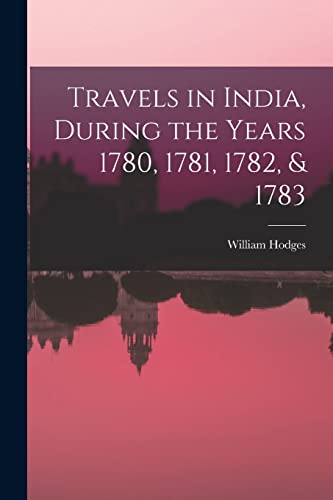
![Seller image for [COOK] Four nineteenth-century photographs of eighteenth-century engravings of Tahitian subjects. for sale by Douglas Stewart Fine Books](https://pictures.abebooks.com/inventory/md/md30711457353.jpg)
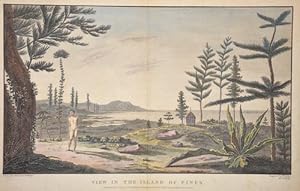
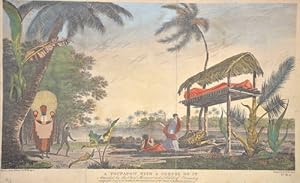


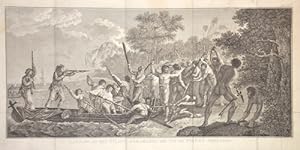
![Seller image for Plate volume for Voyage pittoresque de l'Inde fait dans les années 1780-1783. [Or] Travels in India, during the years 1780, 1781, 1782 & 1783. Original edition. for sale by Wittenborn Art Books](https://pictures.abebooks.com/inventory/md/md31010493153.jpg)
